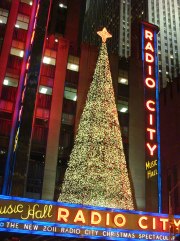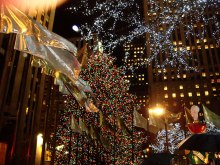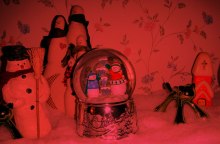Wait, what? Christmas is over, right? Well, yes, the holidays have come and gone again. January is always a little bit of a downer, isn’t it? Especially if it was an enjoyable season. The holidays can certainly be a difficult time too, but this year was great for me and I was inspired to write this post and put it up now before I forget or the year gets away from me. You can come back after Thanksgiving and it will be here if you are Holiday-ed out.
As I said in another post, right before Christmas I played a gig, my first in over a year. It was a GypsyJazz/Jazz type holiday gig and it went very well. Playing the gig got me thinking — musicians are expected to play Christmas songs and holiday music during the holidays, and many do. For some, it’s a chore and a real groan-fest, but personally, I’ve always enjoyed it. This year we played 5 songs in our 3 sets: My Favorite Things, Django Reinhardt’s version of Danse Norvegienne, our own arrangement of Let it Snow, a rowdy version of The Ventures Sleigh Ride (a real crowd pleaser) and a loose arrangement of Vince Guaraldi’s Christmas Time is Here that I have been playing for years. Since we had a clarinet player sitting in with us there was a very classy and Christmas-y vibe to all of these songs, even the ones that aren’t specifically holiday songs. I also heard a whole lot of Christmas music during the season and I’m sure everyone else did as well. So where did these songs come from? What makes a great Christmas carol? As a musician, should you and how can you work some holiday cheer into your repertoire?
Well, some history. The holiday that is Christmas evolved out of pagan, solstice, end of calendar (or seasonal) year celebrations a long, long time ago. The earliest Carols were sung in Europe thousands of years ago and were probably sung in celebration of all four seasons, but it is really the end of year, (Christmas) songs and styles that have survived. As early as 129 AD, Christians began appropriating these songs of praise and celebration and that year a Roman Bishop decreed that a song called the Angel’s Hymn should be sung at Christmas service in Rome. However, Christmas carols didn’t really take off with ordinary people until the Middle Ages when St. Francis of Assisi started staging Nativity Plays in Italy. Music was part of these plays and an important factor that changed the acceptance of the songs was that instead of the music being performed in Latin, the language of the Catholic Church, the songs were sung in various native tongues, so the idea spread all over Europe as people were now able to more fully participate in the music and celebrations. This was controversial because in effect it adds an element of showbiz to religious rites, but this made the rites a more integral part of people’s lives, whether in church or not and thus began the Christmas Carol tradition. Or probably begat, if we use the language of the time.
The earliest English Carol was written in 1410 and reads and sounds more like a poem or lullaby than what we would commonly think of as a Christmas carol. There were many other similar type verses written during this time. In 1454, with the invention of the Gutenburg printing press, carols could be printed and distributed but, believe or not, severe factions within churches did not encourage such vocal celebrations. Oliver Cromwell actually banned Christmas Carols in England during the mid-1600s. And you thought The Grinch was bad! The first American Christmas Carol was written sometime in the 1640s by a man named John de Brebeurf and was called Jesus is Born (The Huron Carol). Though many churches in Europe would refuse to make carols a part of their celebration well into the 19th century, this was not true of ALL churches and the songs were composed and performed by theater companies, musicians, troubadours, and, of course, by great composers like George Frideric Handel and his very grand and famous Messiah, which was first performed in 1742. Or, from much simpler beginnings came arguably, the most famous Christmas carol of all, Silent Night. In 1818 an Austrian assistant priest named Joseph Mohr composed this three stanza ditty to be sung chorally at Christmas mass because the church organ was broken and could not be repaired in time for the holiday celebration. The first time the song was played the congregation heard the priest and choir director Franz Xaver Gruber sing accompanied by Fr. Mohr’s guitar. As it turns out, the guitar was Fr. Mohr’s favorite instrument! Silent Night would, spread across the world as a great song and would be the central carol to the 1914 spontaneous Christmas Truce between warring factions on the Western Front during World War 1. And it all started basically as a religious singer-songwriter guitar tune. Pretty cool, eh?
Over the course of the last 150 years Christmas carols became an integral part of the Christmas and holiday celebrations and they became ever more popular (and big business too!). Bing Crosby‘s version of White Christmas is the best-selling single of all time according to various sources, with sales in excess of 100 million. Wow! Amazing what grows from such humble beginnings? Can you imagine the holiday season without the music we all know so well? In many ways, on a very emotional level, the music defines what we know and feel about the holiday season; the services, the memories, the presents, the dinners, the parties, the decorations, the celebrations, the stories, in sacred and secular manner. In the realm of modern discourse and pop culture it is no longer necessary or possible to separate the story of Jesus’ birth from the Christmas tree or Santa Claus. Over the years music has helped meld all of these elements together into this one big event that everyone recognizes. This is probably what terrified those early church leaders and why they tried so hard to prevent the secular carols from becoming a part of religious celebrations.
Nothing illustrates the Christmas package better than The Charlie Brown Christmas Special with the accompanying soundtrack by the Vince Guaraldi Trio. This classic from 1965 has entertained millions of children and adults for more than 50 years. Elements of the show include Charlie Brown bemoaning the commercialization of Christmas, Snoopy winning a best decoration competition, Linus reciting the appropriate Biblical canon concerning the birth of Jesus Christ and a very unimpressive tree turned into the season’s most important symbol. It has been televised every year since it debuted and even today ABC currently holds the rights and broadcasts the Special twice in the weeks before Christmas. Guaraldi’s soundtrack has also sold well; over 4 million copies! While most of the people involved thought the show would be a disaster due to it’s slow pacing, simple animation, and weird mix of jazz and sacred (choir) music, it was a hit from the first broadcast. The show and the soundtrack are among the most loved holiday entertainment in the United States and you can check out the rankings HERE if you are interested. As with the Peanuts crew or St. Francis of Assisi’s church, the first few years I was in school we had an annual Christmas pageant. Two of the years I even had speaking roles and this was my first taste of performing. I’m sure this is true for many of you out there and this is what tradition is all about!
The 1950s and 1960s was a very classic time for a certain type of holiday music and nothing better represents this time than this album by Fred Waring and The Pennsylvanians — The Sounds of Christmas. Known during his lifetime as America’s Singing Master or The Man Who Taught America to Sing, Fred began with a self-created banjo orchestra that, over time, blossomed into one of mid-20th century America’s great Arts institutions. He also…wait for it, invented the Waring Blender. Because he came from the jazz background of the great bandleaders, there was always a whole lot of SWING and a fair amount of BLUES in the choral presentations, so in addition to perfect vocalizations there is also a whole lot of HIP Daddy-o! While he released many albums and was on television frequently during the late 40s and 50s, that was all way before my time. However, my parents had this record and hearing it instantly takes me back to holidays of yore. Fred Waring was described as a perfectionist and a taskmaster and the performances on this album are flawless. There are many examples of different groups trying to do the same arrangements on YouTube and I haven’t found one yet that is quite as sharp.
The album covers a wide range of styles: Swing (Ring Those Christmas Bells, Santa Claus is Coming To Town); nostalgia (Opening, Carol Brothers Carol [written by W.A. Muhlenberg, who founded St. Lukes Hospital in New York City and was very influential in the development of early American Education]); Porgy and Bess style blues (Rise Up Shepherd an’ Foller, Go Where I Send Thee); the classics (Silent Night, O Holy Night) and six songs that were written by another jazz musician, unknown at the time, by the name of Alfred Burt. His carols began as a family tradition to accompany the yearly Christmas card to friends and relatives and were first heard outside the family circle in the early 1950s. He composed all of the music for these carols and family friend Wilha Hutson wrote the lyrics and they were a hit with choir groups that heard them. Hollywood recordings quickly commenced, but unfortunately, Burt did not live to see his creations sung and popularized by the likes of Nat King Cole, Tennessee Ernie Ford and Fred Waring. They were very popular at the time and since then the carols have entered the popular Christmas music lexicon and there they have remained. This album contains: Caroling, Caroling, O Hearken Ye, Jesu Parvule, The Star Carol, Come Dear Children, and This Is Christmas.
While many of these carols, like all carols, are very simple in structure, Waring’s arrangements take them to interesting places and the talent assembled to perform them was obviously top-notch. They do not make albums like this anymore! The Sounds of Christmas is available again so either relive the magic (if you grew up with it like I did) or check it out for yourself! It gets a 5-star rating on Amazon so I obviously know what I’m talking about *wink*!
Okay! Look for the conclusion to follow next week. Like a ride through the woods to Grandma’s house the posts will lead back to the guitar and how you can make Christmas songs your own!
Here is Part 2 of this series.


